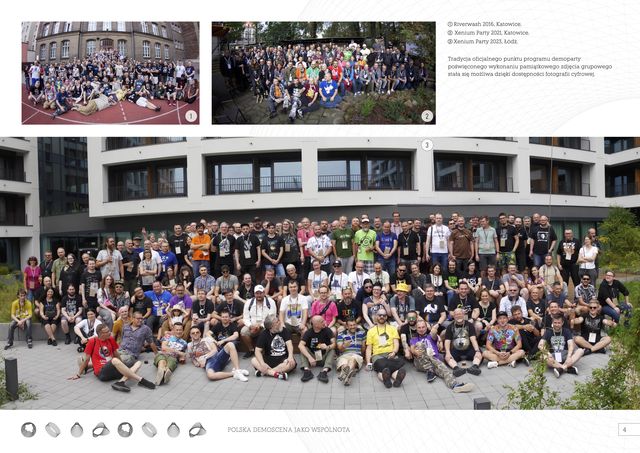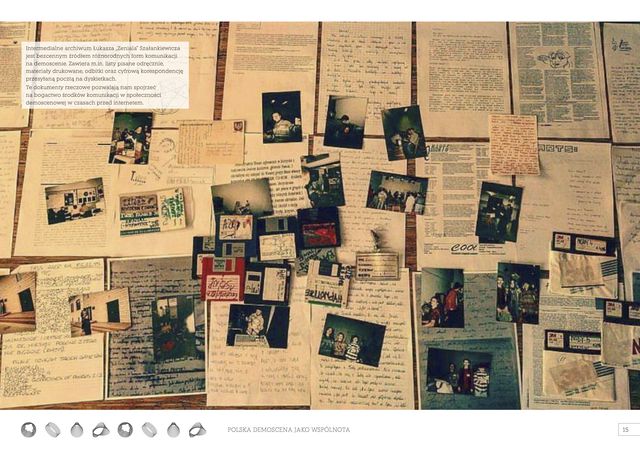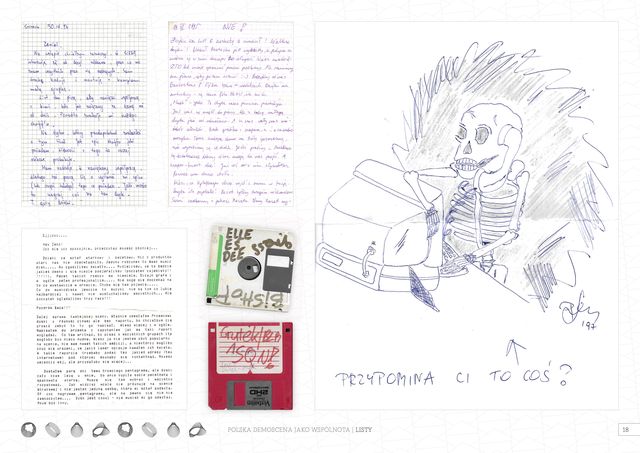
Thanks to the support of the National Heritage Institute under the “Intangible – Pass It On” program, and in cooperation with the distinguished sociologist Dr. Patryk Wasiak, we have released an album titled “Polish Demoscene as a Community. Informal Practices of Polish Demoscene Contacts”.

Our goal was to gather, preserve, and disseminate knowledge about the communication practices and the creation of their own identity by the Polish demoscene. The same demoscene that we managed to register on the National List of Intangible Cultural Heritage.

Fewer and fewer people remember sending letters and distributing demos on floppy disks. Both the way of this correspondence and the practice of enriching envelopes and floppy disks with a creative visual layer are an important element of the intangible heritage of the demoscene. To our surprise, the album turned out to be important not only for us. Here is a letter we received after publication, which we decided to publish with the author’s permission (translation is ours):
Lublin, 28.11. 2023Dear Mr. Andrzej,
The album “Polish Demoscene as a Community. Informal Practices of Polish Demoscene Contacts” (2023), which you released as part of the MKiDN and NID program “Intangible - Pass It On,” has come into my hands. I must admit that it made a huge positive impression on me. You have done an incredibly important and great job, and I see its greatness in several dimensions. First, the illustrative and factual material that members of the Polish demoscene have collected, archived, described, and preserved over these 30 years of your subculture’s existence, constitutes not only documentation of a cultural phenomenon but also testifies to your long-term, continuous, communal commitment to building your archives. Today, in the era of fashion for social archives, we call it grassroots social archives of the Polish demoscene. Second, therefore, presenting at least part of your archives’ collections in the album certifies that the demoscene community is a community of dozens of people integrated around their heritage, and I hope that your publication will encourage other groups of intangible cultural heritage depositors in Poland (listed on the National list and aspiring to be listed) to consciously document practices of internal, informal communication.
Third, you have shown the multiplicity of forms of this communication – for example, I appreciate the selection of materials that show gestures serving to maintain and strengthen relationships, in photographs of working at computers, playing, meetings, greetings, parties, debates, etc., as well as in letters (with notes on envelopes, with graphics, floppy disks, etc.). Reading the album chapter titled “Letters” offers a chance for a unique insight into the system of communication, friendship, communal worldview, communal demoscene value system. By deciding to make this public, you create an opportunity for analysis of this material by researchers from many disciplines, such as historians, sociologists, and anthropologists of culture, axiologists, cultural studies scholars, linguists, and this is, in my opinion, the fourth argument for the importance of your publication. The photos are properly labeled, which will facilitate these analyses, as will the standardized statements of Polish demoscene representatives in the “Interviews” chapter. If you have nothing against it, I will allow myself to inquire about the dates of these interviews in the future and use them soon for a paper at a scientific conference.
Finally, fifthly, I look at the album from the perspective of a layperson, someone who intuitively feels that the demoscene is an important element on the Polish map of intangible heritage (I’m keeping my fingers crossed for it to be recognized also by a quick entry on the UNESCO List along with scenes from other countries). And from this point of view, I very much appreciate that I can learn about the demoscene from the album: get to know terms, forms of demoscene artistic expressions, your jargon, functions in groups (e.g., swapper), get to know a bit of the scene’s history – the chronological arrangement of photos in the publication greatly facilitates this.
I’ve written quite a bit, sorry, but let this convince you that this publication was worth your work and should have a continuation in an English version, printed and as a Part II, for instance, about the communication of the Polish demoscene in the age of the internet. At first glance, it seems like only 45 pages, but with each page, this “only” increasingly demands quotation marks, as the wealth of knowledge and emotions these pages contain is immense. I’ve been your fan since I got acquainted with the application for the entry of the Polish demoscene into the National List of Intangible Cultural Heritage, but since I got to know the album, I’ve become your ambassador.
Mr. Andrzej, thank you again for the album and I wish you prosperity in everything, especially in what will lead the Polish demoscene onto the UNESCO List!
Katarzyna Smyk

We invite you to explore the >ALBUM<.
KPD NEWS

Thanks to the support of the National Heritage Institute within the “Intangible – Pass It On” program, and in collaboration with the distinguished sociologist Dr. Patryk Wasiak, we released an album titled “Polish Demoscene as a Community. Informal Practices of Polish Demoscene Contacts”. (more...)

Our representation, consisting of Andrzej “angelo” Lichnerowicz and Łukasz “zenial” Szałankiewicz, was invited to The Celebration of the Intangible Cultural Heritage Festival in Zakopane. (more...)

The creativity of our demoscene now belongs to the digital heritage of Polish culture. And now, buckle up because it’s going to be classy. Thanks to the involvement of the Polish demoscene community, the Chronicle of Polish Demoscene Committee created and submitted an application for entry into the National List of Intangible Cultural Heritage. Today, a signed document has reached us. The application was accepted. (more...)
